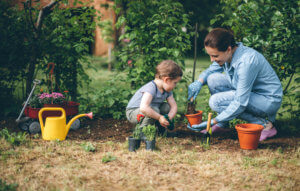A beautiful garden may do more than attract complimentary neighbors. As these lush and fragrant spaces invite admirers, they also bring about unwanted visitors. Care for your garden improperly, and you may as well be rolling out the red carpet to your house for a host of pests. From stink bugs to ants, these garden pests can become a true nuisance once they enter your home. To keep garden pests from becoming a problem, consider the following steps:
1. Keep your garden several feet away from your home and outdoor patio areas.
Gardens create a niche ecosystem for plants, fungi, animals and insects to survive, creating a wonderful learning experience for you and your family. However, you’d probably rather not have these ecosystems inside your home or in other outdoor areas.

Many of the pests that frequent gardens, such as stink bugs, ladybugs, ground beetles and millipedes, are what we in pest control call “occasional invaders.” Occasional invaders love your garden, only entering the home when they need a reprieve from a rainstorm or colder weather. Therefore, the further away you plant your garden, the less likely these pests are to make the journey into your home. You’ll also want to make sure your garden is a good distance from your outdoor seating areas. Placing your garden close to where you grill, eat or lounge increases the chance that pests such as mosquitoes and other stinging insects will disturb you. If possible, keep your garden far enough from these areas so that your pests are contained to that space.
2. Ensure taller plants do not touch or brush up against your house.
We’ve established that your garden should be a good distance from your home, but landscaping is also a key player in keeping garden pests out. All shrubbery should be planted at least two feet from your home’s exterior and kept well-maintained so that no part of the plant touches your house. This goes for tree limbs, too – make sure no limbs are touching your roof or side paneling. Plants and tree limbs act as ladders for pests like ants, and even larger wildlife, to enter your home.
These pests are more threatening than your standard occasional invader. While ants are beneficial to garden ecosystems, they can become a hard-to-eliminate problem once they enter your home, as all they need are crumbs to survive! Wildlife can harm your home’s structural integrity, damage belongings and cause uncleanliness and health concerns.

3. Learn the pros and cons of certain plants and gardening materials.
Certain plants and gardening materials can create inviting conditions for pests to enter your garden. For example, the sugar found in fruit-bearing plants welcomes pests like troublesome ants and stinging pests. You’ll want to take this into consideration when choosing whether to include them in your garden, as well as where to place them.
Woodgrain mulch and woodchips can also be troublesome. Adding water to these wood-based fertilizers makes your garden the perfect hideaway for moisture-loving termites. When preparing your outdoor space, research which plants and materials are best to incorporate.
4. Prioritize garden maintenance.
While it may seem obvious that you should keep your garden well-maintained, it’s very common for this to fall to the wayside when life gets busy. However, this can quickly turn your balanced ecosystem into a haven for pests. Prevent this by weeding regularly, as weeds create dense vegetation that provides additional hiding spots for pests and locks in moisture that mosquitoes can use to breed. When weeding your garden, make sure to limit spray treatments, as they can cause pests to flee to a new home, presumably yours.
If fruits and vegetables are planted in your garden, it’s critical to harvest them regularly. Rotting vegetables and fruits create a surplus of food among relatively untouched vegetation, which invites wildlife pests, such as squirrels, chipmunks, groundhogs and raccoons. These furry pests can be a real threat to your home regardless of how far away your garden is from your house – unlike insects, they can easily travel hundreds of feet.
Following these guidelines will help keep your garden beautiful and your home pest-free. Interested in additional home, garden and landscaping tips? Consider involving your pest control provider. As pest experts, they can help you prepare for garden pests and their unwelcome friends.